No. 17, Vol. 2. Autumnal Equinox 2009

In issue thirteen of the JWMT appeared an article on sacred geometry derived from the proto-kabalistic text The Sefer Yetzirah. That article described a way to read the first five chapters to develop what is commonly referred to as the “Cube of Space” and discussed its relationship to the aura and the kabbalistic souls. The current article builds upon the previous and will discuss a kabbalistic tarot in relation to the Sefer Yetzirah, but also later kabbalistic text. As the Sefer Yetzirah deals with the letters of the Hebrew alefbet this article will focus on the corresponding major arcana of the tarot, which are associated with those letters. This will include not only their placement on the Cube, and on the Tree of Life, but will also imply interpretations of those cards based on their location on the Cube and the sefirot that surrounds it as well as how they may be understood because of their location on the Tree of Life.
The cards of the so-called “major arcana,” the series of twenty-two image bearing or “trump” cards, of the modern tarot deck have been associated, in one way or another, with the twenty-two letters of the Hebrew alefbet for over two hundred years. Though developed by the likes of Papus and Eliphas Lévi Zahed modern decks that employ those letters are largely derived from the tarot work of Samuel Liddell “MacGregor” Mathers, one of the founders of the Order of the Golden Dawn. Following this are decks based on the work of Aleister Crowley in his Book of Thoth, and A.E. Waite’s Key to the Tarot, both of whom based their tarots on Mathers’ work.
The Golden Dawn’s attribution of the letters to the trumps is founded on William Wynn Westcott’s “corrected” translation of the Sefer Yetzirah, a proto-kabalistic text dating from between the third through sixth centuries C.E. Later tarot enthusiasts have used a similar ideology in developing the “Cube of Space,” much as I had done in the issue thirteen of the JWMT. One difference, however, is that previous authors have been working from the perspective of modern magical qabalah while my own perspective is derived more from traditional Jewish kabbalah. Applying this to the Cube of Space and the tarot creates a somewhat different, and very interesting, understanding of the trump cards.
Importantly, I am not claiming to represent the “correct” version of the tarot. The tarot was derived from a game; there is no “correct” version. To make such a claim is to mistake the map for the terrain. However, there are possibly some systems that work better than others and, worse, some things that present themselves as systems that, ultimately, are dead ends. Not having mistaken the map for the terrain, we must read our maps carefully if we are to proceed forward at all.
Over the last few centuries there has been any number of different orderings, names, etc. of the major arcana. Some early decks, designed for game play rather than divination, have included upwards of thirty trumps. Standardization of the trumps, their names and order has only occurred in the last one hundred or so years. This article will use the following set of card to letter attributions. I refer you to the previous article for a greater understanding of how the letter-to-sign correspondences were derived.
Table
1: Association of Letters, Signs and Cards
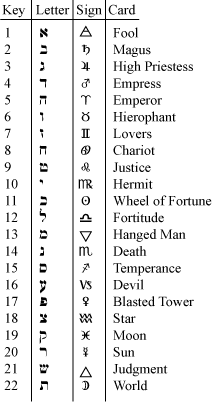
It
is important
to note that I have decided to keep the usual letter-card
attributions.[1]
This means that the planets here are not necessarily associated with
the same
cards as found in modern tarot decks.
Shelosh Imot - Three Mother
Verse
six of the
third chapter of the Sefer
Yetzirah
tells of the position of the three Mother letters,  ,
,  ,
,  :
:
The
head is created from fire,
The
belly is created from water,
And
the chest, from breath,
Decides
between them.[2]
The Sefer Yetzirah is here describing parts of what will eventually be known as Adam Kadmon, the Holy or Divine Human. Though Rabbi Isaac Luria will eventually associate this with one of his five kabbalistic worlds it is also a term sometimes used to refer to the human form on the Tree of Life itself. Through this ideology the triad of Keter-Chokmah-Binah make up the head, Chesed and Gevurah the right and left arms,[3] Tiferet the torso or trunk of the body, Netzach and Hod the right and left legs, Yesod the phallus[4] and Malkhut the feet.
The twenty-two
extra-sefirotic paths of the Tree of Life are divided into
three horizontal, seven vertical and twelve diagonal lines. These
perfectly
mimic the divisions of the Mother letters, Double letters and the
Simples.
Placing the Mothers becomes a simple matter at this point. Breath,
given to the
letter A decides between fire ( )
and water (
)
and water ( ),
and is located at the level of
the
chest. The path corresponding to this letter runs between Chesed and
Gevurah.
Fire, the head, runs between Chokmah and Binah and Mem, the belly,
between
Netzach and Hod.
),
and is located at the level of
the
chest. The path corresponding to this letter runs between Chesed and
Gevurah.
Fire, the head, runs between Chokmah and Binah and Mem, the belly,
between
Netzach and Hod.
Diagram
1: The Mothers on the Tree of Life
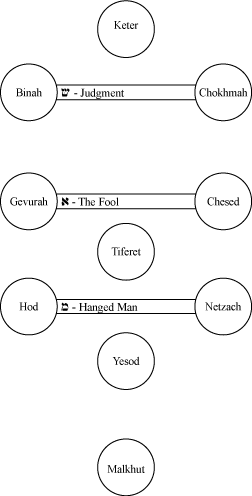
Placement on the Cube of Space is an easy prospect at this point. Following the previous article we find that the Mothers run through the X, Y and Z axes. This is demonstrated in the diagram below:
Diagram 2: The Mothers in the Cube of Space
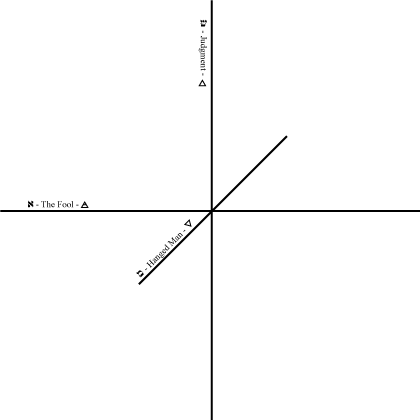
As you will recall, the
three-way axis formed by the Mothers extend through
the cube of space, connecting to
the sefirot
beyond. A connects to
Chesed and Gevurah,  to
Netzach and Hod and
to
Netzach and Hod and  to
Tiferet and Yesod.
This
double connection, each of the Mothers being situated between not
two,
but four[5]
will be important when it
comes to interpreting the cards.
to
Tiferet and Yesod.
This
double connection, each of the Mothers being situated between not
two,
but four[5]
will be important when it
comes to interpreting the cards.
Alef:
To this letter is given the element of air and the Fool card. For some
time it has been given the
number 0 and placed either towards
the end of the deck or at the
beginning, with
the advent of Mathers’ “corrected”
sequencing. Kabbalistically one might suggest that it is more
appropriately give then number 1. There
are at least
three possible reasons for this. First, it is the first card and the
first
element, from which the others come from. In gimatria
there is no number 0, so 1 is entirely appropriate and it is the
gimatric value of the letter  .
Second, and equally important,
.
Second, and equally important,  ,
and
all the letters
after it, are distinctly in manifestation, it is only Ayin Sof, the
fully
transcendent deity, that is innumerable. Finally, the Fool is the card
of beginnings, but not of origination; it is not the nothing from which
everything came, but the very first something, walking the balanced
path between
water and
fire, love and fear.
,
and
all the letters
after it, are distinctly in manifestation, it is only Ayin Sof, the
fully
transcendent deity, that is innumerable. Finally, the Fool is the card
of beginnings, but not of origination; it is not the nothing from which
everything came, but the very first something, walking the balanced
path between
water and
fire, love and fear.
Mem:  is
the 13th
key of the tarot, associated with the Mother
element of water and the Hanged Man card.
Given water’s association with Chesed it may seem that the
Hanged Man is an unlikely match. However water is also an element used
for punishment,
such as seen in the Biblical story of the flood. The path between
Netzach and
Hod has to do, amongst other things, with divine protection and the
cessation
of divine protection.[6]
It is we who have tied
ourselves up, whether or not we will be freed before the water rises
depends upon our actions in this world, whether or not we have gained
protection or have lost it and so will suffer for our falling in with
the
“evil inclination.”
is
the 13th
key of the tarot, associated with the Mother
element of water and the Hanged Man card.
Given water’s association with Chesed it may seem that the
Hanged Man is an unlikely match. However water is also an element used
for punishment,
such as seen in the Biblical story of the flood. The path between
Netzach and
Hod has to do, amongst other things, with divine protection and the
cessation
of divine protection.[6]
It is we who have tied
ourselves up, whether or not we will be freed before the water rises
depends upon our actions in this world, whether or not we have gained
protection or have lost it and so will suffer for our falling in with
the
“evil inclination.”
Shin:
The 21st
key of the
tarot and the second to last letter,  has
attributed to it the
element of fire and the Judgment card. The sefira
Gevurah is given to the idea of judgment and so
has
attributed to it the
element of fire and the Judgment card. The sefira
Gevurah is given to the idea of judgment and so  ,
with its Gevuric
fire, is entirely appropriate here and no more explanation is needed.
,
with its Gevuric
fire, is entirely appropriate here and no more explanation is needed.
Shevah
Kefulot - Seven
Doubles
The
fourth chapter of the Sefer
Yetzirah
explains the role and placement of the seven Double letters and their
planetary
associations. Having already established the Mothers as the horizontal
lines on
the Tree of Life, the Doubles are naturally placed on the seven
vertical lines.
Again, the association of the letters and planets has already been
established.
As mentioned in the introduction, in order to maintain some semblance
with the
now normative positioning of the letters, signs and trumps on the Tree
of Life,
I have decided to link the planets with their Hebrew letters, rather
than their
tarot cards.
Table
2: Letters,
Planets, Cards
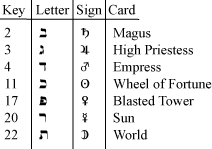
The same idea that
caused this ordering, the use of the
Chaldean order of the planets, will also help us place the Doubles on
the Tree
of Life. This is necessary as even though we know they are to be placed
on the
verticals, the Sefer
Yetzirah is not
as obvious about their individual
placement as it is for the Mothers.
However,
for exact placement, we will also turn to the earliest of the of
kabbalistic
texts, the Sefer
ha-Bahir.
In
a theme that will be
later taken up by the Zohar,
the Bahir
discusses the natures of many of the Hebrew letters. These
brief discussions will help us place the Double letters on the Tree of
Life, causing an apparent change to their perhaps logical order. Thus,
as you
will see, the letter  will be placed
beneath Chokmah, the second sefira
and not Keter, the first.
will be placed
beneath Chokmah, the second sefira
and not Keter, the first.
Diagram
3: The Doubles on the Tree of Life
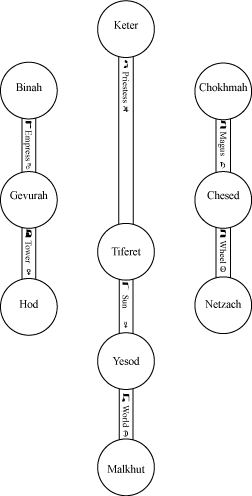
It is obvious from diagram two that even though the cards are being associated with the same letters as with the modern forms of tarot, their positioning on the Tree of Life is radically different as it does not employ the “path of return” model used in modern decks.[7] Also, and perhaps more radically, the card-sign relationships are altered, as they were with the Mother letters. A brief discussion of the reasoning behind how the letters are placed on the Tree of Life follows:
Bet:
The Bahir,[8]
playing on the etymology of the name of the letter  ,
tells us that we
should
not read it as “bet,”
the letter, but
“bayit,”
“house.” It quotes Proverbs
24:3, saying: “With Wisdom the house is built. . .”
Thus
,
tells us that we
should
not read it as “bet,”
the letter, but
“bayit,”
“house.” It quotes Proverbs
24:3, saying: “With Wisdom the house is built. . .”
Thus  and
Chokmah, wisdom,
become directly related in kabbalistic thought. Further,
the Zohar[9]
tells us that the Bible begins with the letter
and
Chokmah, wisdom,
become directly related in kabbalistic thought. Further,
the Zohar[9]
tells us that the Bible begins with the letter  because it is the
letter of
blessings, connecting the idea of beginnings with the letter. The
kabbalists
associated the ten depths of creation mentioned in the Sefer
Yetzirah with
the ten sefirot.[10]
Most
commonly they decided that Chokmah represented the depth of beginning,
further
establishing an association between
because it is the
letter of
blessings, connecting the idea of beginnings with the letter. The
kabbalists
associated the ten depths of creation mentioned in the Sefer
Yetzirah with
the ten sefirot.[10]
Most
commonly they decided that Chokmah represented the depth of beginning,
further
establishing an association between  and
Chokmah. As this is a Double
letter,
the only place for it is descending vertically from Chokmah to Chesed,
where
the blessings will fill the “cup of blessing” found
in the sefira
of Loving Kindness.
and
Chokmah. As this is a Double
letter,
the only place for it is descending vertically from Chokmah to Chesed,
where
the blessings will fill the “cup of blessing” found
in the sefira
of Loving Kindness.
To  is
given the Magus
card and the planet Saturn.
Astrologically, Saturn is the great teacher whose slow lessons give us
wisdom.
This is the role of the Magus, the knower of all wisdom. It is through
this wisdom,
which is experiential, not just intellectual, that the Magus is able to
manipulate the world as he does. As Chokmah contains the blueprint of
all
possible creation the path of the Magus is one of supernal wisdom. For
this
reason we might rename the card Theurgos or Theurgist, the God-Worker,
which in
Neoplatonic cosmology is associated with Nous, or the Divine Mind.
is
given the Magus
card and the planet Saturn.
Astrologically, Saturn is the great teacher whose slow lessons give us
wisdom.
This is the role of the Magus, the knower of all wisdom. It is through
this wisdom,
which is experiential, not just intellectual, that the Magus is able to
manipulate the world as he does. As Chokmah contains the blueprint of
all
possible creation the path of the Magus is one of supernal wisdom. For
this
reason we might rename the card Theurgos or Theurgist, the God-Worker,
which in
Neoplatonic cosmology is associated with Nous, or the Divine Mind.
Gimel:
The letter  is
described as something that
renders (gomel)
kindness.
is
described as something that
renders (gomel)
kindness.  is
to render goodness
to the lower sefirot,
to the poor.[11]
All
of the sefirot
are poor in comparison
to Keter, for it is from Keter that
everything else emanates. Thus
is
to render goodness
to the lower sefirot,
to the poor.[11]
All
of the sefirot
are poor in comparison
to Keter, for it is from Keter that
everything else emanates. Thus  ,
with its
attribution of “wealth”[12]
can
only be appropriately placed beneath
Keter, the source of all spiritual wealth.
,
with its
attribution of “wealth”[12]
can
only be appropriately placed beneath
Keter, the source of all spiritual wealth.
Gimel is the High Priestess and the planet Jupiter. The rendering of kindness, the blessings of Keter is highly appropriate for Jupiter, the greater benefic. Here the High Priestess might be seen as a kind of Upper Shekhinah, hinting not only at the Empress descending from Binah but the World card that leads into Malkhut. These two cards, the High Priestess and the World, may be seen and upper and lower reflections of one another. The High Priestess’ work, like that of the Magus/Theurgos, is truly spiritual in nature, leading us only higher and higher on the path of tikun, rectification.
Dalet: According to the Bahir,[13] dalet represents poverty (dal, poor). This may be read as an allusion to the Shekhinah and Malkhut, both of which ultimately stem from Binah, through Gevurah. Malkhut is “poor” because it does not give its own blessings; it only receives them from above. D is also given the power of “seed” in the Sefer Yetzirah, an appropriate power for Binah, who is also called Ima, mother.[14]
The
Empress card is
associated with  ,
along with the
planet Mars. This is significantly different from its now normative
planetary
correspondence, Venus. The martial ideology here is a reflection of
kabbalistic
thought. Binah, as the head of the left-hand pillar, is the source of
all severity
and restriction. It is through the power of restriction that all
creation
comes, symbolized by the pregnant Empress. This idea is reflected in
Genesis,
where the name of God that creates is Elohim. This, according to
kabbalistic
tradition, is the divine name of Binah when spoken.[15]
Mythologically, it could also be added that the Roman god Mars, though
a god of
war, was a god of crops as well, linking the above ideas together.
,
along with the
planet Mars. This is significantly different from its now normative
planetary
correspondence, Venus. The martial ideology here is a reflection of
kabbalistic
thought. Binah, as the head of the left-hand pillar, is the source of
all severity
and restriction. It is through the power of restriction that all
creation
comes, symbolized by the pregnant Empress. This idea is reflected in
Genesis,
where the name of God that creates is Elohim. This, according to
kabbalistic
tradition, is the divine name of Binah when spoken.[15]
Mythologically, it could also be added that the Roman god Mars, though
a god of
war, was a god of crops as well, linking the above ideas together.
Kaf:
The fourth Double letter, K, comes
from kaf,
the palm of the hand. Of this it is
written that the palm is called a “pan of merit” (kaf
zechut).
In the Sefer Yetzirah the
“pan of merit” is
associated
with the letter  as
the element of water, which is given to Chesed,
loving
kindness.[16]
Further, K has the power of “life,” which is only
appropriate for the
life-giving sun.[17]
as
the element of water, which is given to Chesed,
loving
kindness.[16]
Further, K has the power of “life,” which is only
appropriate for the
life-giving sun.[17]
The 11th key is the Wheel of Fortune, connected to the Sun. In the modern systems this card is given to Jupiter and represents, ultimately, good fortune. The idea of the Sun connected to fortune has a kabbalistic precedent. According to the Zohar whether or not one will have children is a matter of fate, mazel. Mazel has the literal meaning of “star,”[18] of which, of course, ours is the sun. So, we pray for good fortune, loving kindness stemming from Chesed, for the giving of children, one of the greatest blessings a couple can have in Jewish thought. This can, of course, be seen symbolically as representing good fortune in general, so its placement here in fact replaces the planetary attribution of the modern deck.
Peh:  ,
to
which is given the planet Venus,
descends from Gevurah and has the power
of
“Dominance” given to it by the Sefer
Yetzirah.[19]
The Bahir
is silent about
,
to
which is given the planet Venus,
descends from Gevurah and has the power
of
“Dominance” given to it by the Sefer
Yetzirah.[19]
The Bahir
is silent about  ,
though given
its commentary on
,
though given
its commentary on  ,
and the Zoharic attribution of Luna for
,
and the Zoharic attribution of Luna for  suggest
this is
the only other place for the letter to be placed.
suggest
this is
the only other place for the letter to be placed.
Normally
associated
with Mars, here  is given to Venus
and the Blasted Tower.
While the Tower may be the Tower
of Babel, which was destroyed because
of the arrogance of humanity,
that
destruction also allows for new growth, life and rectification, a major
theme
of kabbalistic works, especially after Rabbi Isaac Luria. The Zohar
simultaneously associates
is given to Venus
and the Blasted Tower.
While the Tower may be the Tower
of Babel, which was destroyed because
of the arrogance of humanity,
that
destruction also allows for new growth, life and rectification, a major
theme
of kabbalistic works, especially after Rabbi Isaac Luria. The Zohar
simultaneously associates  with
redemption (purqena)
but also the serpent by the shape of its body.
Traditionally kabbalistic sources blame Eve, Venus, for humanity being
exiled
from the Garden of Eden by being tempted by the serpent, opening the
way of the
evil inclination, represented by the serpent, to dominate the world. It
is
through the Shekhinah, or in Christian belief theVirgin
Mary, that this will be rectified. So the Tower can be seen as a
symbol of
both destruction and resolution.
with
redemption (purqena)
but also the serpent by the shape of its body.
Traditionally kabbalistic sources blame Eve, Venus, for humanity being
exiled
from the Garden of Eden by being tempted by the serpent, opening the
way of the
evil inclination, represented by the serpent, to dominate the world. It
is
through the Shekhinah, or in Christian belief theVirgin
Mary, that this will be rectified. So the Tower can be seen as a
symbol of
both destruction and resolution.
Resh:
The Bahir[20]
says that The
letter Tav:
The last of the Doubles, indeed the
last
letter of the alefbet is In
the Cube of Space
the planets form a secondary axis,
supported by the Mother letters. Unlike the Mothers, the axis of the
Doubles
extends only to the perimeter of the Cube of Space, which is made up of
the
Simple letters. The Doubles, with their tarot and planetary
attributions, are
as follows: Diagram
4: The Doubles in the Cube of Space Unlike
as with the Mothers, which have a double set of trump-between-sefirot
attributions, the Doubles do not
extend beyond the Cube of Space. That
being said, as we will see, the
sphere of
the sefirot
described in the previous
article will come to influence the Doubles, in fact all of the letters,
in
unexpected ways. Shtem
Esray Pashutot -
Twelve Simples
Twelve
Elemental Table
3: Letters, Signs, Cards There
are many different ways that the Simples can be placed on their paths.
For
instance there is an emanatory method. Each sefira,
with the exception of Malkhut, projects from it one or more netivot,
paths. The emanatory method
simply allows for the paths to extend naturally and chronologically,
with each sefira
emanating its path(s) before the
next. In the cases of Keter, Chokmah and Binah, all of which have two,
or three
in the case of Keter, netivot
leading
from them, rather than one, paths are projected first to the higher
then the
lower sefira Diagram
5: The Simples on the Tree of Life It
will be noticed that unlike in the form of the Tree of Life used by
most modern
qabalists, there are no diagonal paths connected to Malkhut. This is in
keeping
with kabbalistic doctrine that Shekhinah receives only through union
with
Yesod, the divine phallus, and nothing else.[25]
The reader should also notice that this creates a fundamentally
different
looking Tree of Life from what is found in most modern books on the
qabalistic
tarot. Its attributions also differ greatly from versions of the Tree
of Life
given by the Gra and Rabbi Isaac Luria. Associated
with Aries and the
Emperor, Vav:
Corresponding to Zayin: Chet: Tet: Yod:
The
card connected with Lamed:
Typically Justice is attributed
to Lamed, but here it is Fortitude, its sign is Libra. Lamed is the ox
goad,
and idea which connects this card to Nun:
The
sign that corresponds to Samekh:
This
is the Temperance card,
associated with Sagittarius, a sign of spiritual seeking. Samekh is the
support
of the world, holding up the
fallen.[36]
This idea works well with Netzach, which is accorded the role of giving
divine
protection to those who need it.[37]
The power associated with Ayin: Tzaddi:
The
Star and Aquarius,
connecting Netzach and Yesod. Khof:
Finally, Chapter
5:2 of the Sefer
Yetzirah gives us
explicit directions for the placement of the diagonal paths to create
the
actual Cube of Space proper.
The
east upper
boundary The
implication here is
that the letters should be
placed in the above sequence according to how they were listed in four
sets of
three in the earlier portion of the same section. Diagram
6: The Simples forming the Cube of Space The
so-called “Cube of Space” isn’t exactly a
cube, however. The boundaries
described in chapter 5:2 do not form a six-sided shape but a four-sided
one,
the top and bottom are open, perhaps allowing for the influx of
supernal energy
into the quasi-cube. Or, as Netzach and Hod are
associated with the
gifts of
vision and prophecy,[46]
this may be the opening through which those gifts are brought into
manifestation. That these two sides are
open is not entirely relevant
to the
current discussion, though perhaps interesting given the general
subject
matter; i.e. divination. The
Cube of Space, as it pertains directly to the tarot trumps, is now
complete.
However, these first five chapters of the Sefer
Yetzirah
don’t deal
solely with the letters of the alefbet; they also
discuss the sefirot
belimah,
the sefirot
of nothing. The role these sefirot
play here has to do with the
overall influence they have on different sections of the Cube, and how
that
influence relates to the trumps there and their interpretations. The
next
section of this paper will discuss the how all of this reflects upon
those
interpretations. Part
II: The Influences of the Cube of Space and External Sefirot
on the Trumps Table
4: The Sefirot and the Quarters The
whole system can be
seen in the following diagram: Diagram
7: The External Sefirot and their
Influence on the Cube of Space When
the above diagram is
broken down, we see that each quarter has within it multiple letters.
The cards
of these letters fall under the influence of the sefira
that dominates the quarter that it is in. The sole exception
to this is Beneath
this is another of
influences, determined by the six depths that correspond to the six
directions.
This will create a second set of influences. Though this becomes very
difficult
to represent graphically, the follow set of tables in Chart 1
demonstrates how
the externals influence sefirot
of
the six directions. Chart 2 shows how they influence the letters and
Chart 3
how the sefirot
of the six direction
influence the letters. Missing from these charts is the letter  is
the root of every tree.
Leading into Yesod, the root or
foundation of the Tree of Life, we can see that
is
the root of every tree.
Leading into Yesod, the root or
foundation of the Tree of Life, we can see that  is
thus logically
placed.
This logic of discussing Yesod rather than Tiferet directly is
continued in a
kabbalistic interpretation of the Sefer
Yetzirah.
Here
is
thus logically
placed.
This logic of discussing Yesod rather than Tiferet directly is
continued in a
kabbalistic interpretation of the Sefer
Yetzirah.
Here  is given the
power of “peace,” shalom,
a title of Yesod.[21]
is given the
power of “peace,” shalom,
a title of Yesod.[21]
 is here
associated with the Sun card and the
planet Mercury, which is the planet closest to the sun. The Sun card is
here
appropriately placed between Tiferet and Yesod, both of which are
symbolized by
the sun in kabbalistic texts. It is the sun, the Bride Groom or Blessed
Holy
One that connects to the moon, Shekhinah, a kabbalistic pageantry of
the higher
self coming into the lower and rectifying it. Thus this card may be
said to
represent the completion of a cycle, with the higher and lower married,
with
new prospects in the future.
is here
associated with the Sun card and the
planet Mercury, which is the planet closest to the sun. The Sun card is
here
appropriately placed between Tiferet and Yesod, both of which are
symbolized by
the sun in kabbalistic texts. It is the sun, the Bride Groom or Blessed
Holy
One that connects to the moon, Shekhinah, a kabbalistic pageantry of
the higher
self coming into the lower and rectifying it. Thus this card may be
said to
represent the completion of a cycle, with the higher and lower married,
with
new prospects in the future. , to
which is given the moon. According to
Aryeh
Kaplan, in his commentary on the Bahir
and its discussion of tohu,
“chaos,”
the letter
, to
which is given the moon. According to
Aryeh
Kaplan, in his commentary on the Bahir
and its discussion of tohu,
“chaos,”
the letter  ,
being the final letter, represents Malkhut, the final
sefira.[22]
More
significantly, the Zohar
makes
constant allusions to the full moon being the symbolic manifestation of
the
Shekhinah, the presence of God in creation.[23]
Thus,
it can be seen how the World, Malkhut, is entirely appropriate for this
letter
and its position.
,
being the final letter, represents Malkhut, the final
sefira.[22]
More
significantly, the Zohar
makes
constant allusions to the full moon being the symbolic manifestation of
the
Shekhinah, the presence of God in creation.[23]
Thus,
it can be seen how the World, Malkhut, is entirely appropriate for this
letter
and its position.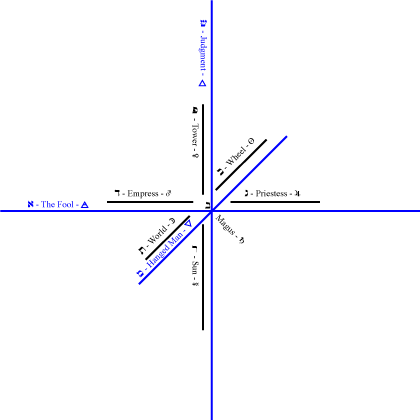
Chapter
five of the Sefer
Yetzirah
deals with
the Simple letters, which are associated with the signs of the zodiac.
Of all
the chapters of this short text, this is the
most explicit about the
placement
of the letters, telling us their general position on the Tree of Life
and their
precise position in what will make up the actual cube part of the Cube
of
Space.












Their
foundation is the twelve diagonal
boundaries.[24] 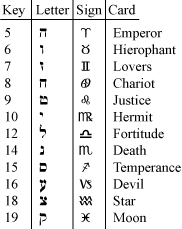
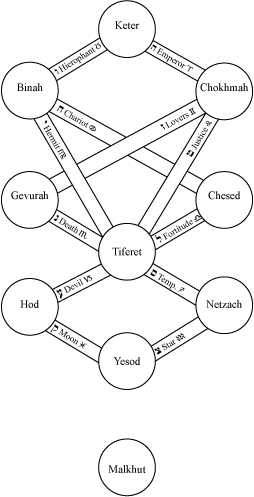
 has
the 5th
key of the tarot. Though this card’s
attributions are in keeping with modern tarot decks, its placement is
not. To H
is given the power of speech,[26]
the ultimate creative act in all of the Abrahamic religions. As the
first of
the Simples to come from Keter it is fitting that the first and most
proactive
zodiacal sign be associated with it. The Emperor is here the true King,
descending from the Crown, empowering the divine Will of Chokmah with
sacred
and creative speech.
has
the 5th
key of the tarot. Though this card’s
attributions are in keeping with modern tarot decks, its placement is
not. To H
is given the power of speech,[26]
the ultimate creative act in all of the Abrahamic religions. As the
first of
the Simples to come from Keter it is fitting that the first and most
proactive
zodiacal sign be associated with it. The Emperor is here the true King,
descending from the Crown, empowering the divine Will of Chokmah with
sacred
and creative speech. is
the sign of
Taurus and the Hierophant card. The Hierophant is a card of creation,
something
that gives shape. The numerical value
of the letter
is
the sign of
Taurus and the Hierophant card. The Hierophant is a card of creation,
something
that gives shape. The numerical value
of the letter  is six, which
alludes to
the six directions in space and the six seals of the Divine name that
surround
it.[27]
This is appropriate for a card that inspires Binah, which means
intuition and
understanding and is given the power of thought. [28]
It is this thought that gives meaning and form to the speech
of
is six, which
alludes to
the six directions in space and the six seals of the Divine name that
surround
it.[27]
This is appropriate for a card that inspires Binah, which means
intuition and
understanding and is given the power of thought. [28]
It is this thought that gives meaning and form to the speech
of  .
. has associated with
it the
Lovers card and Gemini. This netivah runs between Chokmah and Gevurah,
which is
perhaps fitting for a letters whose very image,
is that of a sword[29]
and whose name means “weapon."
has associated with
it the
Lovers card and Gemini. This netivah runs between Chokmah and Gevurah,
which is
perhaps fitting for a letters whose very image,
is that of a sword[29]
and whose name means “weapon."  is given the power
of motion according to the Sefer
Yetzirah.[30]
Coupled with Gemini, the twins, we have the suggestion of strife or the
sword
of God cleaving between two things to separate and restrain them as
found in
the beginning of the alchemical process, which is necessary to create
the
perfect gold.
is given the power
of motion according to the Sefer
Yetzirah.[30]
Coupled with Gemini, the twins, we have the suggestion of strife or the
sword
of God cleaving between two things to separate and restrain them as
found in
the beginning of the alchemical process, which is necessary to create
the
perfect gold. is the Chariot and Cancer. It
has the power of sight as bridges the gap between Binah, the supernal
Mother,
and Chesed, the lower father. The chariot is the merkavah
or throne upon which the Upper
Shekhinah,
Binah. We see upon the chariot the image of God, a
vision of creation in its supernal form; the union of Mother and
Father. It is
this chariot that carries us from the lower sefirot
to the Supernals. The feminine nature of Cancer supports both the image
of the
Shekhinah as chariot rider and the armored chariot itself.>
is the Chariot and Cancer. It
has the power of sight as bridges the gap between Binah, the supernal
Mother,
and Chesed, the lower father. The chariot is the merkavah
or throne upon which the Upper
Shekhinah,
Binah. We see upon the chariot the image of God, a
vision of creation in its supernal form; the union of Mother and
Father. It is
this chariot that carries us from the lower sefirot
to the Supernals. The feminine nature of Cancer supports both the image
of the
Shekhinah as chariot rider and the armored chariot itself.> leads
from Chokmah to Tiferet
and is associated with Justice and Leo. Justice is a fitting card for
this path
as Tiferet is the sefira
of justice
and true justice can only come from the Supernals, which exist beyond
the
subjective realm. Justice occurs through the careful listening
of the
complaint
and deciding with wisdom, and hearing is the power associated with this
letter.[31]
Leo is the honorable lion, which is also a
symbol for Christ streaming
down from the Father. Courage is necessary
in the carrying out of justice, as it is often the case that we do what
is
easy, not what is right.
leads
from Chokmah to Tiferet
and is associated with Justice and Leo. Justice is a fitting card for
this path
as Tiferet is the sefira
of justice
and true justice can only come from the Supernals, which exist beyond
the
subjective realm. Justice occurs through the careful listening
of the
complaint
and deciding with wisdom, and hearing is the power associated with this
letter.[31]
Leo is the honorable lion, which is also a
symbol for Christ streaming
down from the Father. Courage is necessary
in the carrying out of justice, as it is often the case that we do what
is
easy, not what is right. is
the
Hermit, its sign Virgo.
is
the
Hermit, its sign Virgo.  connects Binah, the Mother, and Tiferet, the
son. The
power of
connects Binah, the Mother, and Tiferet, the
son. The
power of  is
action,[32]
which, along with its receiving of power from Binah, seems
contradictory to the
idea of the virgin and the reclusive hermit. However, the virginal
hermit is
one who, through action and compassion has rectified themselves,
overcoming the
evil inclination in order to lead others along the path of tikkun
is
action,[32]
which, along with its receiving of power from Binah, seems
contradictory to the
idea of the virgin and the reclusive hermit. However, the virginal
hermit is
one who, through action and compassion has rectified themselves,
overcoming the
evil inclination in order to lead others along the path of tikkun ,
the ox. Fortitude
can be seen as the perseverance of moving under pressure, the
goad moving the ox. It also speaks of a requisite spiritual fortitude
necessary
to move from the place of beauty beyond, to higher levels of
spirituality that
are not so easily gained, and
never gained without trial and ordeal.
This is
represented by the woman taming a lion on the trump. Classically the
soul was
seen as being feminine in nature, thus it depicts the soul in its
ordeal. Lamed
is also associated with kingship,[33]
as Tiferet is the king of the Kingdom, Malkhut. The ordeal must be met
and
passed for that kingship to remain, and for it to vivify the world it
must be
tempered with loving kindness.
,
the ox. Fortitude
can be seen as the perseverance of moving under pressure, the
goad moving the ox. It also speaks of a requisite spiritual fortitude
necessary
to move from the place of beauty beyond, to higher levels of
spirituality that
are not so easily gained, and
never gained without trial and ordeal.
This is
represented by the woman taming a lion on the trump. Classically the
soul was
seen as being feminine in nature, thus it depicts the soul in its
ordeal. Lamed
is also associated with kingship,[33]
as Tiferet is the king of the Kingdom, Malkhut. The ordeal must be met
and
passed for that kingship to remain, and for it to vivify the world it
must be
tempered with loving kindness. is
Scorpio,
the card is Death, which connects
Gevurah and Tiferet. The power of
is
Scorpio,
the card is Death, which connects
Gevurah and Tiferet. The power of  is
that of smell,[34]
fitting for Death. The letter is also association with nofelim,
fallen,[35]
as all eventually fall to death, who is called the End of all Flesh.
is
that of smell,[34]
fitting for Death. The letter is also association with nofelim,
fallen,[35]
as all eventually fall to death, who is called the End of all Flesh. is sleep, which is also fitting, as
Netzach, along
with Hod, are responsible for the spiritual gifts of vision and
prophecy.[38]
is sleep, which is also fitting, as
Netzach, along
with Hod, are responsible for the spiritual gifts of vision and
prophecy.[38] is
the Devil and Capricorn,
connecting Tiferet to Hod. Whereas Netzach is given authority to
protect, Hod
withdraws that protection,[39]
leaving us vulnerable when we have given ourselves to the evil
inclination,
which is associated with Satan and the power of anger[40].
Further,
is
the Devil and Capricorn,
connecting Tiferet to Hod. Whereas Netzach is given authority to
protect, Hod
withdraws that protection,[39]
leaving us vulnerable when we have given ourselves to the evil
inclination,
which is associated with Satan and the power of anger[40].
Further,  is
associated with avon,
iniquity.[41]
is
associated with avon,
iniquity.[41] is tzaddikim,
the righteous of the world, which is associated
with Yesod.[42]
It
has the power of taste,[43]
which refers to the flowing water coming from the water
bearer’s vessel; this
is the flow of divine blessings from above, originally being poured out
from
the High Priestess.
is tzaddikim,
the righteous of the world, which is associated
with Yesod.[42]
It
has the power of taste,[43]
which refers to the flowing water coming from the water
bearer’s vessel; this
is the flow of divine blessings from above, originally being poured out
from
the High Priestess. is
the Moon, which is
associated with Pisces and the power
of laughter.[44]
Khof is associated with deceit,[45]
the most common trait of the new moon, which is given over to the power
of the
Evil Inclination and Satan. It was for this reason that the Azazel goat
sacrifice was implemented, to distract the Evil Inclination so the
blessings
from above could descend unmolested.
is
the Moon, which is
associated with Pisces and the power
of laughter.[44]
Khof is associated with deceit,[45]
the most common trait of the new moon, which is given over to the power
of the
Evil Inclination and Satan. It was for this reason that the Azazel goat
sacrifice was implemented, to distract the Evil Inclination so the
blessings
from above could descend unmolested.
The
east northern
boundary
The
east lower
boundary
The
south
upper boundary
The
south
eastern boundary
The
south
lower boundary
The
west upper
boundary
The
west southern
boundary
The
west lower
boundary
The
north
upper boundary
The
north
western boundary
The
north lower boundary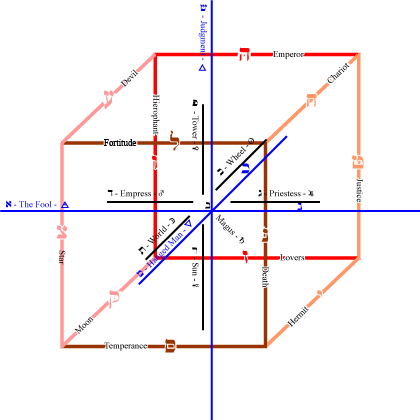
The
Cube of Space, as defined
by the twelve diagonals of the Simple
letters, is
surrounded by two sets of sefirot. The first are those outside of the
whole
system, designated by the Sefer
Yetzirah
as Beginning (Chokmah) and End (Binah), Good (Keter)
and Evil (Malkhut).[47]
In accordance with their relative positions on the Tree of Life, I have
placed
these four sefirot around the other depths. These sefirot cut the
sphere created
by the six directions in space into four quarters. Each of these
quarters is
influenced by their respective sefira:

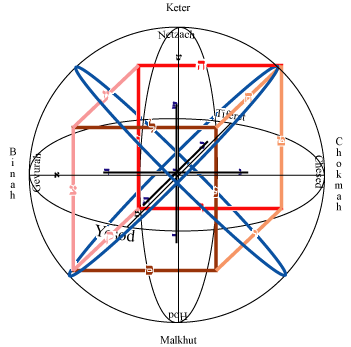
 ,
which lies in the precise center of the sphere and is
either
influenced by all four of the surrounding sefirot
or none. Given the hypercube that will form around the center of the
Cube, the
former is more likely than the later. Also,
some of the Simple letters,
being on the borders dividing the quarters, will fall under the
influence of
more than one sefirot.
The Mothers
will likewise be associated with the powers of two sefirot
as they pierce the central access of the Cube.
,
which lies in the precise center of the sphere and is
either
influenced by all four of the surrounding sefirot
or none. Given the hypercube that will form around the center of the
Cube, the
former is more likely than the later. Also,
some of the Simple letters,
being on the borders dividing the quarters, will fall under the
influence of
more than one sefirot.
The Mothers
will likewise be associated with the powers of two sefirot
as they pierce the central access of the Cube.  ,
which
is
affected by all the sefirot.
,
which
is
affected by all the sefirot.
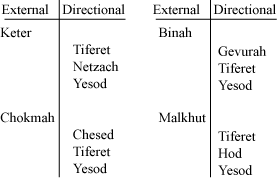

Chart 3: Directionals/Letters

As can be seen each letters, and thus each chard, is governed by not only its astrological sign but multiple sefirot.
What does all of this mean for a kabbalistic tarot? In fact, many things. First, and perhaps most importantly, it allows for a richly complex cosmology. This in turn will affect the use of the cards both for scrying and for divination. In designing each trump the confluence of forces can, and should, be taken into considering, providing for multiple levels of symbolism for interpretation. Also, as the minor arcane and the court cards can be placed on this system, it is a complete system.
On a practical magical level, much as discussed in the previous article, this system also creates a map of energies present in any magical space that is created using this ideology. Thus, for instance, physical postures can be developed to tap into these energies, much like the Order of the Golden Dawn’s grade signs. It also suggests initiatory purposes wherein each progressive initiation moves the candidate through different portions of the hall corresponding to the various levels discussed here and elsewhere.
The tarot is a deeply rich cosmological system. When attached to a kabbalistic paradigm that richness is enhanced many times. Through the Sefer Yetzirah and kabbalistic texts such as the Bahir and Zohar a complex and complete system can be developed to enhance both one’s magical and spiritual journey. The map thus created consists not only of a five-dimensional hyper-cube but one with external and internal structures that can be utilized to explore both the micro- and macrocosm. Such a system must be carefully produced and, more importantly, explored. It will be through a complete investigation of the kabbalistic tarot that its true fruits will be harvested.
[1] With one exception for those who are used to a Golden Dawn style set of attributes. The version above pre-dates the Golden Dawn’s attributes (Christopher I. Lehrich, The Occult Mind: In Theory and Practice (Ithica, NY: Cornell University Press, 2007), 135).
[2]Aryeh Kaplan, trans., Sefer Yetzirah: The Book of Creation (York Beach, ME: Weiser Books, 1997), 3:6. As with the previous articles, unless otherwise stated, all quotations from the Sefer Yetzirah are from the Kaplan translation.
[3] Respectively. Traditional kabbalah does not reverse the right and left sides as later hermetic qabalah does. Thus, in texts such as the Zohar, constant references to the “Left-hand side,” the side of the demonic derived from Gevurah, are made.
[4] Traditionally Yesod was associated with the place of the Covenant, the circumcised penis. Though generally considered masculine, Yesod is also the place of union between the Blessed Holy One (Tiferet) and Shekhinah (Malkhut) and a portion of its Divine Name, Shaddai, shares a root with the Hebrew words for “mountain” and “breast,” suggesting a hidden feminine side as well.
[5] With the exception of A, which is lays between Chesed and Gevurah on both the Cube and the Tree of Life. This, in and of itself, suggests something about the nature of A and the Fool card.
[6] This theme is woven throughout the chapter on Netzach and Hod in Gikatilla’s Sha’are Orah. Joseph Gikatilla, Gates of Light: Sha’are Orah, trans. Avi Weinstein (San Franscisco: Harper Collins Publishers, 1994), 115-146.
[7] This model traces the letters going sequentially down from Keter to Malkhut, These can then be followed back upwards forming the Golden Dawn’s “Serpent of Wisdom.”
[8] Aryeh Kaplan, trans., The Bahir: Illumination (York Beach, ME: Weiser Books, 1979), 6.
[9]
Daniel C. Matt, trans., The
Zohar
(Stanford:
[10] C.f. Kaplan, Sefer Yetzirah, 44-6.
[12] Kaplan, Sefer Yetzirah, 4:9
[14]
C.f.
Geoffrey W. Dennis, The
Encyclopedia of
Jewish Myth, Magic and Mysticism
(
[15] It is spelled YHVH but said Elohim. See, for example, Gikatilla, Gates, 283.
[16] Kaplan, I believe, mistakenly associates the three Mothers with Keter, Chokmah and Binah. The Zohar fully establishes Chesed, Gevurah and Tiferet as being archetypal for mercy, judgment and balance; i.e. the scale described by the Sefer Yetzirah. See, for example Parsha Bo, 201.
[17] Kaplan, Sefer Yetzirah, 175.
[18] C.f. Matt, Zohar, 1:115a, 1:137a.
[21]< 4:16; Gikatilla, Gates 66-7.
[23] C.f. Matt, Zohar, 1:136a,1:237a.
[25] C.f. Gikatilla, Gates, 55.
[26] Kaplan, Sefer Yetzirah, 5:7.
[27] Kaplan, Bahir, 12. This refers to the numerical value of the letter.
[28] Kaplan, Sefer Yetzirah, 5:7.
[34] Kaplan, Sefer Yetzirah, 5:8.
[37] Gikatilla, Gates, 115-146.
[40] Kaplan, Sefer Yetzirah, 5:9.
[43] Kaplan, Sefer Yetzirah, 5:9.